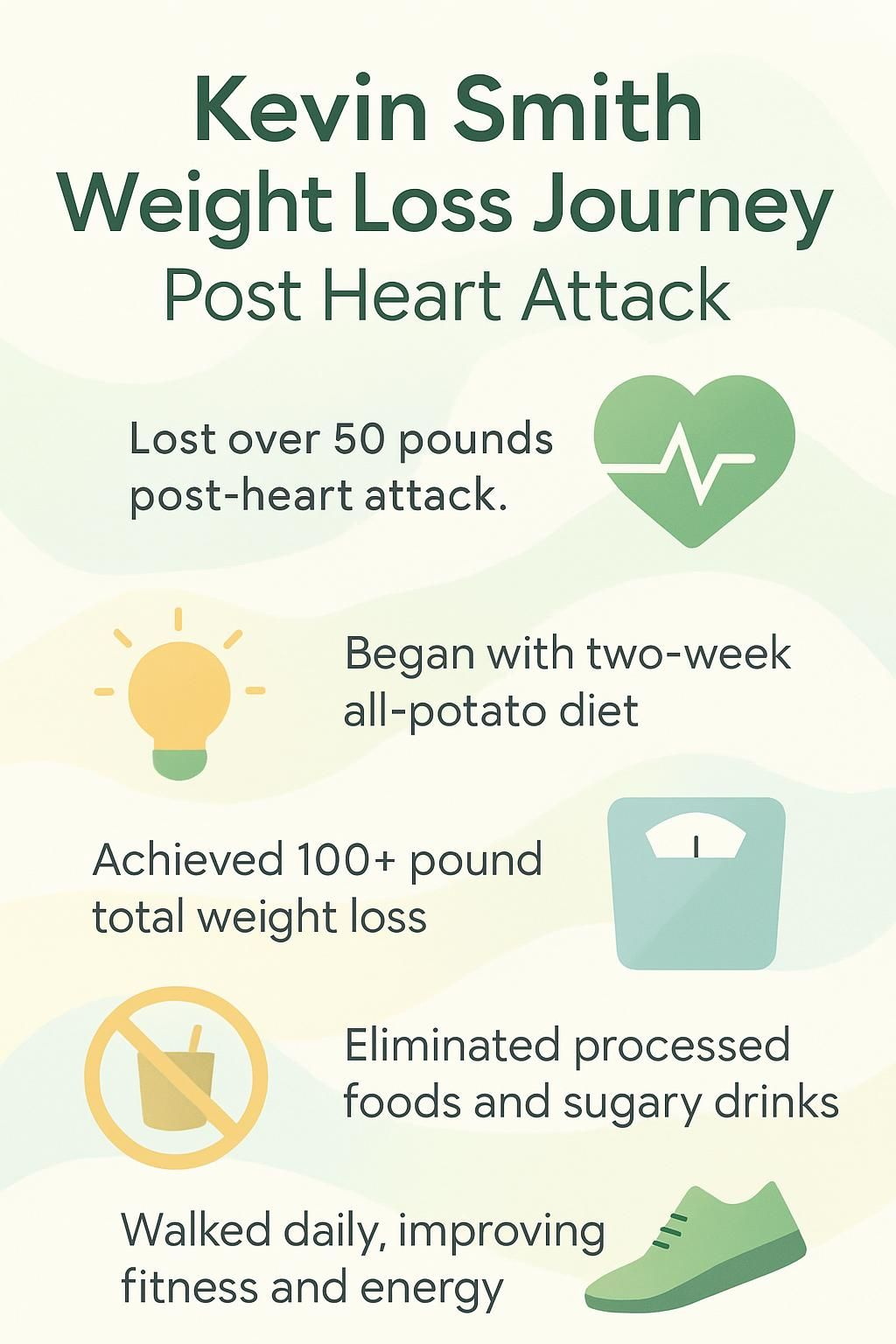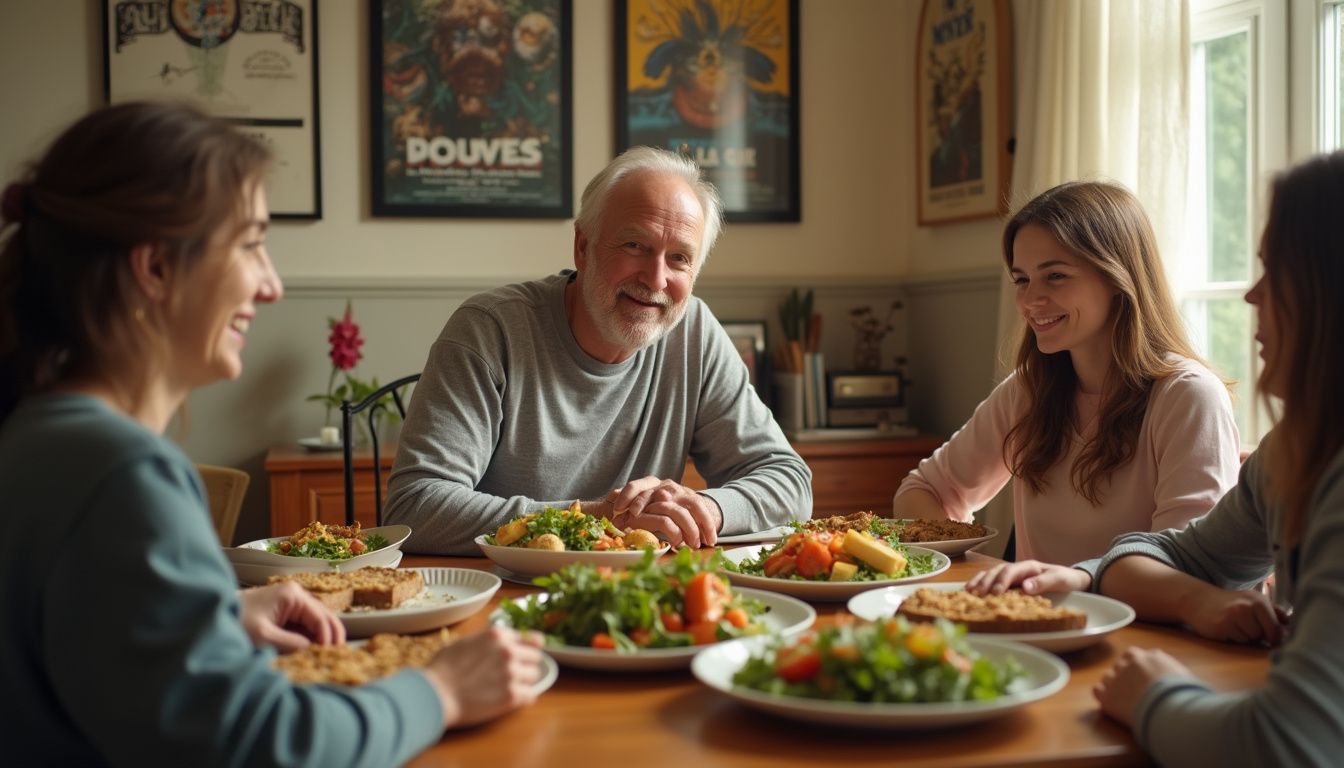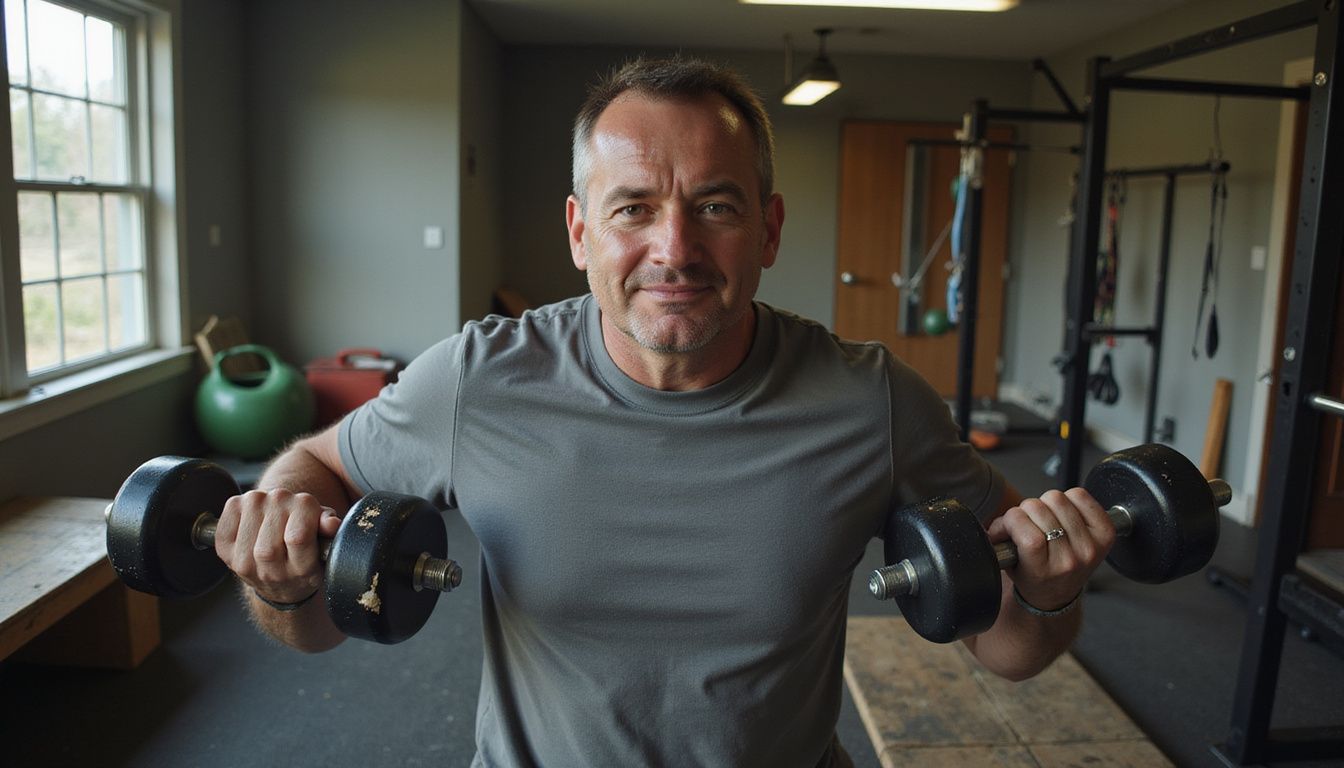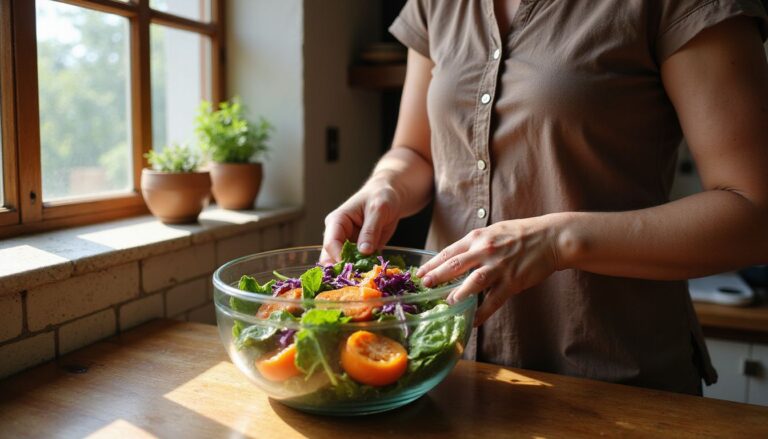Kevin Smith Weight Loss Journey Post Heart Attack
Our Nutrition Assistant AI Suite will transform your body. You will lose fat, get toned, and build muscle. Gain confidence and optimal health.
You might struggle to change habits after a scare with your heart. Kevin Smith faced that moment in 2018 after a massive heart attack. His weight loss story shows clear steps that helped him lose 50 pounds and improve heart health with a plant-based diet, steady exercise, and support.
This guide shares what he tried, what stuck, and how you can adapt the same ideas. Use it to build a plan you can keep.
Key Takeaways
- Kevin Smith lost over 50 pounds after his February 25, 2018 heart attack by going vegan, using intermittent fasting, and exercising daily.
- He jump-started progress with a two-week all-potato diet, inspired by performer Penn Jillette, and dropped his first 20 pounds quickly.
- Cutting sugary drinks and processed foods, plus portion control, helped him reach about 100 pounds lost from his highest weight and supported better cholesterol and heart health.
- His vegan daughter, Harley Quinn Smith, and regular updates on Instagram boosted motivation and accountability.
- Daily dog walks led to bigger fitness wins, like hiking hills, more energy, and a brighter mood after the heart event.

How did Kevin Smith’s heart attack change his life?

Kevin Smith’s heart attack on February 25, 2018 arrived without warning after a stand-up show in Los Angeles. Doctors found a full blockage in his anterior descending artery, often called the widow-maker. A myocardial infarction means a heart attack that happens when blood flow to the heart muscle is blocked.
Heart disease runs in his family, so the scare felt personal. He first blamed nausea and sweating on a strong joint, then collapsed. Paramedics rushed him to the hospital, where he learned he had survived a massive heart attack.
Smith calls life after this event his bonus round. He had already started losing weight with WW International, moving from size 5XL to XL. The scare pushed him to change faster, especially with food choices. Overnight, nachos and burgers were out. Plants took the lead.
After my heart stopped, everything changed overnight.
The experience also influenced his creative work, including Clerks III. More than that, it rewired how he viewed food and health, one meal at a time.
Initial steps in his weight loss journey
Right after the heart attack, Smith focused on simple, clear actions. That start built momentum and confidence.
What is the all-potato diet and how did he adopt it?
The all-potato diet means eating only plain potatoes for every meal for a short period. Smith used it for about two weeks as a reset. This strict plan cut calories fast and delivered a 20-pound drop that helped him believe change was possible.
He heard about the method from Penn Jillette, who had his own big weight loss. It is not balanced, since it lacks many nutrients. A registered dietitian would consider it a short-term tool, not a long-term plan. Smith used it to get moving, then shifted to more sustainable habits.
Seeing the scale move early was a powerful boost. Quick wins can help you stick with the deeper changes that follow.
How did he transition to a plant-based diet?
After the potato reset, Smith moved to a vegan lifestyle with help from his daughter, Harley Quinn Smith. Vegan means no meat, dairy, or eggs. He focused on whole foods like vegetables, fruits, beans, lentils, whole grains, nuts, and seeds.
Meals at places like Veggie Grill and swaps like Beyond Meat burgers made the change feel doable. Fiber from plants helps you feel full longer, which can calm cravings for cookies or cake. Diets lower in saturated fat and added sugar often support healthy cholesterol and weight.
Posting meals and snacks, such as crunchy chickpeas or veggie puffs, helped him stay accountable. Sharing progress made the habit stick.
Why did he eliminate sugary drinks and processed foods?
Sugary drinks add calories fast and do not fill you up. Sodas, energy drinks, and sweet coffee drinks can stall weight loss and strain heart health. Smith swapped them for water, unsweetened tea, or black coffee.
Processed snacks tend to be low in nutrients and high in calories. Choosing whole foods, like beans and greens, helps you stay satisfied. Research links lower intake of sugar-sweetened beverages with reduced daily calories and improved metabolic health.[1]
After a stent to open his blocked artery, these shifts supported recovery. Cutting sugar and refined snacks can also help blood pressure and cholesterol. For Smith, that meant better numbers and a plan he could keep.
Key lifestyle changes
Small daily habits became the foundation of his success, like bricks in a steady wall.
How did intermittent fasting play a role in his journey?
Intermittent fasting is an eating schedule that limits when you eat, not what you eat. Smith delayed his first meal until noon and drank unsweetened iced tea in the morning. A shorter eating window can lower total calorie intake and may improve insulin sensitivity in some people.[2]
His plan was flexible, not rigid. That made it easier to avoid mindless snacking and to focus meals on vegetables, beans, and whole grains. While filming Jay and Silent Bob Reboot, he reported steady energy with this rhythm.
If you try fasting, start with a simple window, such as 12 pm to 8 pm. Pair it with nutrient-dense meals and plenty of water.
Why is portion control important in weight loss?
Portion control helped Smith manage how much he ate, even with healthy foods. He checked serving sizes for snacks, like vegetable puffs, and plated smaller amounts at meals.
This habit lowers total calories without complicated rules. It helped him maintain progress after his 2018 heart attack and continue dropping sizes. Portion awareness can be a lifelong skill because it works in any setting, from home to restaurants.
How does mindful eating and label reading help?
Mindful eating means paying attention to what you eat and how it makes you feel. Slowing down helps you spot real hunger and enjoy food more. Smith used the Weight Watchers app to scan labels and find hidden sugars or additives.
Reading labels shows serving sizes, added sugar, and saturated fat at a glance. That knowledge turned guesswork into informed choices. Over time, he went from 256 pounds to about 195, and daily walks felt easier.
Try this at your next meal. Eat without screens, chew slowly, and check the label before opening any snack.
Role of exercise in his transformation
Movement was the engine that kept all the other choices running.
How did daily walks with his dog aid his fitness?
Smith walked with his dog for about an hour each day. Walking is low impact and good for your heart. It burns calories and supports recovery after a cardiac event. Over time, it helped him lose weight and feel stronger.
Consistency mattered more than speed. Regular walks paired well with his plant-based diet. The routine also lifted his mood and built stamina for tougher hikes later.
Even 20 to 30 minutes a day can help. Start with a flat route and add hills as your fitness grows.
What fitness milestones did he achieve, like climbing a childhood hill?
The daily walks built endurance. That new base let him tackle bigger goals. One highlight was climbing a hill in Red Bank, New Jersey that felt impossible when he was young. His wedding ring even loosened as his body size changed.
Cleaning out old hockey jerseys signaled a new chapter. In 2023 he landed a Men’s Health cover shoot. Fans noticed the change and cheered him on, sometimes with playful jokes about his new look.
Reaching milestones boosts confidence. Track your progress with simple wins each week, like a longer route or a faster pace.
The importance of support systems
Change is easier to keep when your circle pulls with you, not against you.
How did his daughter motivate him?
Harley Quinn Smith had already been vegan for three years. She showed her father how to build meals that taste good and fill you up. Her support made the switch less stressful and more fun.
Beyond food, her steady encouragement kept him focused on long-term health. Their bond strengthened as they shared recipes, sat down for plant-based meals, and stayed consistent together.
How did social media provide accountability?
Posting progress online can keep you honest. Smith shared updates about meals, steps, and weight. Followers cheered wins and offered tips during tougher weeks.
Public goals create a gentle push to show up each day. That shared record built momentum that lasted. Many people find that progress photos, food logs, or quick reflections help them stay the course.
He and his community documented each step in his weight loss journey. The encouragement helped him maintain healthy choices across projects and travel.
What benefits did Kevin Smith gain from losing weight?
Weight loss supported his heart, his energy, and his outlook.
How did his heart health and overall fitness improve?
After losing significant weight, Smith’s doctor confirmed his risk for another cardiac event dropped. Daily walking gave his heart steady aerobic work. Aerobic means exercise that uses oxygen, like brisk walking or cycling.
Eating fewer processed foods and added sugars reduced strain on his cardiovascular system. He could climb hills he once avoided. These changes built a stronger base for daily life and work.
Small steps add up. Plant-forward meals and regular movement work together to support long-term heart health.[3]
In what ways did his energy and productivity increase?
A vegan, high-fiber diet gave Smith steady fuel. Cutting sugary drinks and junk snacks meant fewer energy crashes. He handled long promotion tours for Jay & Silent Bob Reboot and still had energy for writing and family time.
More movement improved alertness and mood. With better stamina, he could direct, write, and perform with less fatigue.
How did his mental well-being get enhanced?
Progress can lift your spirits. Fitting into new clothes and reaching personal goals strengthened his confidence. He joked about online comparisons and accepted his new look with humor.
Sharing updates, giving away old jerseys, and reflecting on his journey brought a sense of gratitude. He described 2023 as surreal and felt hopeful about the years ahead.
Kevin Smith’s tips for sustainable weight loss
Lasting change is built from simple actions you repeat.
Why is starting small important for weight loss?
Small steps feel doable. Smith began with a two-week potato reset, then moved to a plant-based plan. Early results boosted confidence and helped him stick with change.
Try one small shift this week. Cut sugary drinks, add one veggie to each meal, or walk 15 minutes a day. Stack wins over time.
How can focusing on consistency beat perfection?
Perfection is not required. Smith walked daily, controlled portions, and kept his eating window simple. A few strong habits can reshape your health.
Track what matters, such as steps, fiber, or added sugar. If you miss a day, return to your routine at the next meal. Progress beats perfect.
How do you find and use a support network?
Start with your inner circle. Ask a family member to join you for walks or help plan meals. Smith’s partnership with his daughter kept him moving forward after his heart attack in 2018.
Social media can widen your support. Share milestones or join a group that matches your goals. Encouragement and ideas from others often help during plateaus or busy weeks.
What inspirational lessons can we learn from Kevin Smith’s journey?
Life can change in a single day, and your next choice still matters. Smith was 47 when he rebuilt his lifestyle. That proves age is not a barrier to better health.
He used humor, honesty, and community to keep going. Sharing the ups and downs gave him strength and inspired others. Your story could do the same for someone else.
Conclusion
Kevin Smith’s weight loss journey shows how clear steps can protect your heart and reshape your life. Daily walking, a plant-based diet, fewer sugary drinks, and a simple eating window made a powerful difference.
Build your plan one action at a time. Get support, track what helps, and stay consistent through busy seasons. If you have heart disease or major risk factors, talk with your healthcare professional before changing your diet or exercise routine.
Sources: [1] Harvard T.H. Chan School of Public Health, Nutrition Source on Sugar-Sweetened Beverages; [2] National Institute on Aging, Intermittent Fasting Overview; [3] American Heart Association, Lifestyle Changes for Heart Attack Survivors.
FAQs
1. What diet changes did Kevin Smith make after his heart attack?
Kevin Smith adopted a plant-based nutrition plan after his heart attack. He focused on whole foods, fruits, vegetables, and reduced processed foods and animal products, as supported by clinical studies showing plant-based diets can improve heart health (Journal of the American Heart Association, 2019).
2. How much weight did Kevin Smith lose through his new nutrition approach?
Kevin Smith lost over 50 pounds by following a plant-focused nutrition regimen and increasing physical activity. Data from the Centers for Disease Control and Prevention indicate that sustained dietary changes and exercise can lead to significant weight loss.
3. Did medical professionals support Kevin Smith’s nutrition choices?
Kevin Smith worked with healthcare providers to guide his dietary decisions post-heart attack. Research from the American College of Cardiology highlights that professional guidance improves outcomes for patients adopting new diets after cardiac events.
4. What can others learn from Kevin Smith’s weight loss journey and nutrition strategy?
Smith’s experience shows that a plant-centered diet and regular exercise can help manage weight and improve heart health after a major health event. His journey demonstrates how evidence-based nutrition choices, supported by medical advice, can lead to lasting lifestyle improvements.
Summary:
Kevin Smith’s post-heart attack weight loss relied on a plant-based nutrition plan, professional support, and consistent physical activity. Clinical data supports these strategies as effective for improving cardiovascular health and achieving sustainable weight management.







